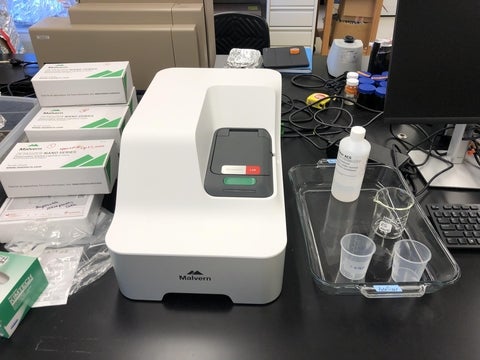EMAL aims at to isolate, identify, quantify, and comprehend the impact of microplastics (MPs) in diverse environments, including water bodies, sediments, or soil.
Armed with expertise and honed skills, we have refined existing extraction methods through meticulous experimentation. Our modifications ensure the effective removal of surface layers of organic contents from extracted MP particles, achieving repeatable accuracies across various particle sizes or morphologies.
EMAL employs Laminate Flow Cabinets to provide clean workspaces for microplastic extraction from natural matrices. Featuring advanced analytical tools such as LDIR and Zeta potential Analyzer, EMAL offers a unique capability for the rapid identification of microplastics particles.
This facility provides comprehensive services, covering both microplastic extraction and identification.
Location: PHY 228
To inquire about these facilities, please contact:
Shuhuan Li
Office: EIT 1003


Laser direct infrared (LDIR) spectrometer
- Agilent 8700 LDIR chemical imaging system
- Major application: analyzing microplastic particle counts, polymer type, and size
- Uses a quantum cascade laser (QCL) with a wavenumber range of 1,800 to 975 cm–1
- Couples QCL with single‑point, thermoelectrically cooled mercury cadmium telluride (MCT) detector and rapid scanning optics to rapidly scan samples
- QCL, MCT and scanning optics enable instrument to quickly image and map microplastic particles in a XX uL volume and obtain IR spectra for particles only to enable rapid analysis and quantification of microplastics in samples

Zeta potential analyzer
- Malvern Zetasizer Nano Z (ZEN2600)
- Determines the zeta potential of particles ranging in size from 3.8 nm to 100 μm
- Also provides sizing of particles using Multi-Angle Dynamic Light Scattering (MADLS)
- Requires sample volumes of at least 12 μL

Stereomicroscope
- Leica EZ4 stereomicroscope
- View and image samples using light shone from above sample
- Major application: Viewing and counting microplastics separated from environmental samples

Laminar Flow Cabinet
- Cole-Parmer® DLF-400 horizontal laminar flow cabinet
- Provides reliable protection for samples and work processes (like microplastic extraction from environmental matrices) from particulates
- ULPA filtration technology creates a clean work environment over a wide range of applications
- Meets and exceeds ISO Class 4 compliance for clean air
- Horizontal flow of filtered air (flows from back to front) does not directly impinge on the work surface, reducing turbulence
- Constructed with powder-coated interior and stainless steel work surface
- High-capacity air handling system delivers flow velocity